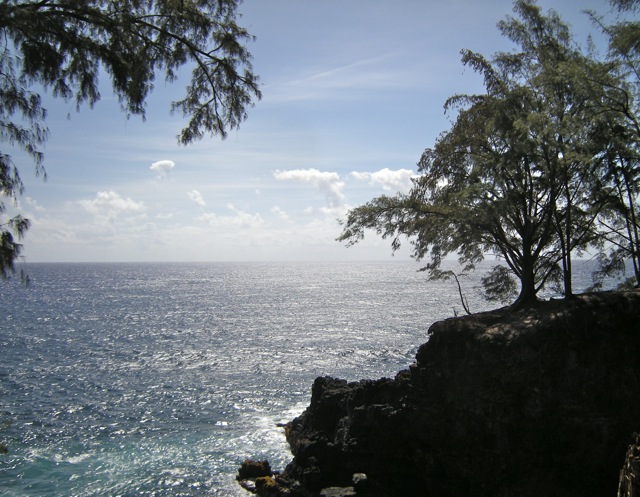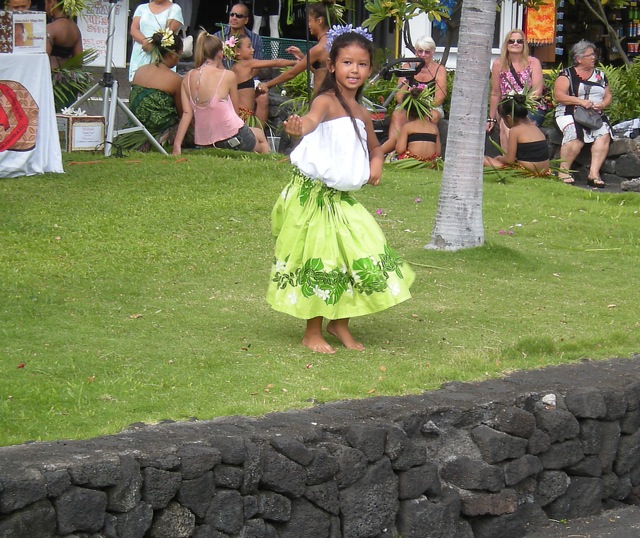… I’m back! Sorry about the two weeks with no posts (and the four weeks with not very many posts). I don’t really have an excuse, but I do have an explanation. First there was my 25th anniversary trip to Hawaii. Kay and I went to the Big Island, renting a cottage near Hilo. It was so beautiful, out in the countryside, and a great place to accomplish our goal of not doing much!
Kay relaxes inside our vacation cottage.
There were beautiful cliffside views of the Pacific Ocean just a short walk away.
Land of dark blue waters.
It took me a while to figure why the ocean water around Hawaii seemed to be a deeper blue than Santa Cruz’s. It’s more of a cobalt blue than a sea blue. Then I realized — it’s not the water, but what’s underneath! You’re standing on a volcano, and the black basaltic rock that you’re standing on keeps going under the surface of the water.
One of the things I wanted to do as much as possible during my trip was watch hula dancing. I saw this cute girl dancing with a hula ensemble at a street fair in Kailua.
Hula dancers start young in Hawaii!
But even more fun than watching it is actually doing it. At the same street fair I ran into a friend named Susan who used to be in the Hula School of Santa Cruz with me. She moved to Hawaii a year or so ago and joined a hula group called Na Wai Iwi Ola, led by Keala Ching. She told me that they have an open practice for beginners once a month at the Sheraton Kona at Keauhou Bay. The open practice was going to be the next night!
Even though it meant a two-hour drive to get there and a two-hour drive to come back, I was game. In fact, this practice was by far the high point of the trip for me. It was my first time practicing with another halau or hula group, and even though it was for “beginners” it was quite intense. We learned a dance called Kapukapu Keauhou (“Sacred is Keauhou”) that Keala Ching had just composed, with a Hawaiian chant that he had also just composed.
What an amazing experience to learn a new dance from the voice of the creator! It told the history of Keauhou Bay, where we were dancing, and also of King Kamehameha III, who was born there. The legend goes that he was not breathing when he was born, so they called a kahuna (witch doctor). He saw the baby’s spirit above them in the cloudy skies and summoned it down to earth, and placed it in the baby’s heart.
Ching’s words told about this story, and then they talked about how life comes around in a circle just like the shore of the bay. The chant was wonderful. It was goosebump-inducing. But of course, you can’t take too much time to admire it because you’ve got to memorize eight lines of Hawaiian verse and learn the hand and foot movements for the dance at the same time! It’s a good workout for the brain as well as for the body.
Another reason that this practice meant so much to me is that the Sheraton Kona is in fact where I saw hula dancing for the first time, when I went to the U.S. Chess Open in 1998. Kay and I went to a luau at the Sheraton that had the usual mix of Polynesian dances, including hula. So I was back 16 years later, only a few hundred feet from where I had first watched hula, only now I was a dancer instead of a watcher! (Of course, dancing in a beginner-level practice is different from dancing on stage at a luau. It’s Class D versus grandmaster. But that was not the point.)
Here I am after the hula practice with Susan Gallery, to whom I am greatly indebted for enabling me to participate in this experience.
Both wearing our Santa Cruz t-shirts. (Susan’s says “Hula School of Santa Cruz.”)
Kay’s favorite activity of the trip was one that I had very low expectations for. We went to Botanical World Gardens and took a tour of the grounds on Segways. It wasn’t high adventure, like riding in a zipline over a cliff. It wasn’t exploring a different world, like snorkeling by the reefs. We’ve been there, done that. This was just tooling around a tropical arboretum on Segways, and Kay loved it! She had never ridden a Segway before, and was pleasantly surprised by how easy it was. I liked the fact that a lot of the trees had interesting and unusual fruit. Did you know that jackfruit is what gave Wrigley’s Juicy Fruit Gum its flavor?
Kay and me after our low-speed adventure.
All in all, it was just about the perfect trip. I was a little bit surprised at how muggy it was in Hilo, but I quickly got used to it, and then when we got back home to Santa Cruz I was surprised at how chilly it was!
Since returning home I have not been studying very much chess, and that is why you have continued to not see very many blog posts. What happened was that I got hooked by a math problem. I don’t know if I wrote about it before, but a couple years ago I started working on a math problem which I spent about a year on, and eventually got a very satisfying solution to that you can read about here. But that kind of whetted my appetite for more math, and so I started looking around for challenging but doable problems that I could work on.
This spring I hit on another one. I’ll put the details at the bottom in case anyone is interested, but suffice to say that for the last three weeks, all the time I would have normally spent on chess instead went into trying to solve this number theory problem.
Well, I had some good ideas and made some progress, but it’s time to bring that to a close. Especially because I e-mailed a number theorist who tracked down a link to a discussion about this very same problem, which said that the problem had been solved in the 1920s. The paper is in German, which I don’t read, but the discussion also provided a reference to an English version of the solution in a number theory textbook.
On the one hand it was satisfying to find that this was a good enough problem that some people have taken trouble to write about it. However, it also shows that any good problem that is solvable has likely already been solved, especially in a well-researched area like number theory.
Anyway, the good news for readers of this blog is that I can now go back to thinking about chess in my spare time, instead of mathematics.
P.S. For any math-lovers wondering what the problem was, here it is: I noticed that 18^2 + 18 + 1 = 7^3. Why is this interesting? Well, it means that if you write 7^3 in base 18, you get 111. That seemed quite surprising to me, because in base 10 none of the numbers 111, 1111, 11111, etc. (called “repunits”) are perfect powers. So I wondered whether any three-digit repunits in any other bases are cubes. Or symbolically, does the equation y^3 = x^2 + x + 1 have any other solutions in positive integers besides x = 18 and y = 7?
There is a very deeply studied field called elliptic curve theory that tells you any such equation can have only finitely many solutions, but it doesn’t give you any good way of telling how many there are exactly, or when you have found the last one. I also knew of a web site that tells you there are no other solutions to this problem that are less than 10 billion. But can you prove that there are no other solutions, period?
I had some ideas how you might be able to do this. The ideas still might work. But it’s been done before. So I’m now going to put my ideas on the way, way, way back burner.







